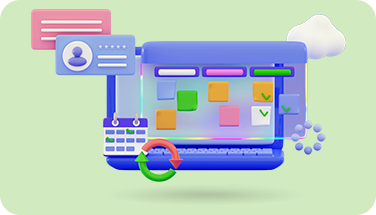Why integrating Financial Planning & Analysis with ERP connects strategy with operations
Those currently using an enterprise resource planning (ERP) system may not realize the benefits that a financial planning and analysis integration, creating a fully integrated ERP suite, can bring.
Naturally, FP&A and ERP systems have the same goal, aligning business functions and digitizing back-office operations so that corporate strategy can be realized with a data-driven and cross-functional response.

Finances are often the heart of any organization, but those still relying on legacy systems, such as Excel or Google Sheets, to manage financial data in parallel to their ERP system will struggle to efficiently respond to the modern demands of finance teams and a CFO.
In this blog, we will highlight why integrating an FP&A system into your ERP system is a natural next step in your digital transformation journey, that will result in more efficient planning and alignment of business functions to identify and achieve organizational goals.
Integrating organizational functions for better planning
Organizations are always on the lookout for a more consistent approach to financial planning and analysis (FP&A).
Suite-based solutions that consolidate ERP and FP&A offerings with Cloud capabilities can align core operational data with finance strategy, allowing enterprises of all sizes to identify, manage, and achieve their corporate goals. This allows organizations to benefit from a cross-functional response across HR, Finance, and even Procurement teams.
In many organizations, be it the public sector, professional services, higher education, or non-profits, operational processes are often disconnected from wider corporate strategy – this can particularly cost when a financial function is atrophied.
Unifying an organization’s operational ERP and financial data can help ensure:
- Corporate strategy can be identified, expounded, and achieved through data
- Operational plans are directly linked to strategic drivers
- Alignment across functions with one singular source of data truth.
- Configurable data flows between ERP and FP&A systems, as well as HR data.
- Each business function can confidently work with the same accurate data
What are the differences between ERP and FP&A systems
When we can manage our data succinctly, we can use this insight to forecast for the future, address existing imbalances, and optimize operations in a way that best suits your organization and customer base, with an added ability to confidently inform executives and investors on the progress made towards corporate strategy.
This all starts by integrating all key business functions under one condensed data model, which is possible thanks to innovation in the Cloud.
Click to read FP&A product brochure gated
What is ERP?
ERP is generally more operational and focused on the day-to-day of an organization: sales orders, reconciliations, procurement, invoicing, timesheets, and HR data can be stored within what is often a static record of processes and transactions.
The functional scope of ERP is generally to have a retrospective static view and is structured with independent tools for different departments and functions.
When fully integrated with other business functions, such as Finance, HR, and Procurement in some cases, an enterprise can qualify and quantify resources, creating a better general corporate strategy and increasing visibility across an organization's resources and data.
Unit4 ERP
- A common data model for fast and easy access to accurate sources of record data
- Cloud-based microservices for added agility, flexibility, and resilience
- Integrated apps for improved visibility of project management and control of finances
What is FP&A?
On the other hand, FP&A is a more strategic and visionary solution focused on areas such as strategic planning, budget creation, revenue forecasting, financial consolidation reporting, and data analytics.
Such a solution is forward-looking and by linking to ERP data organizations can provide a more dynamic view of performance across the enterprise. Planning, budgeting, and forecasting become much simpler with unified systems and data.
Corporate strategy and objectives can be modeled with confidence when an organization gains visibility across all business function data. Allocation of resources and monitoring expenses are more simplified, while ongoing performance can be easily linked to projections and scenario plans.
Unit4 FP&A
- Advanced forecasting capabilities
- Self-service dashboarding
- Optimize planning with out-of-the-box best practices
The benefits of integration
- Improved business insight and decision-making using trusted data
- Mitigate and reduce risk with fewer human errors by automating processes and reporting
- Enhanced efficiency by standardizing best practices and reducing low-value manual tasks
- Lower operational costs by unifying and integrating systems
- Scalability means consistent infrastructure allows systemic growth as your organization evolves
Strong business dependencies exist between FP&A (strategic) and ERP (transactional). Combining both supports daily workflows through increased collaboration, particularly around reporting, analysis, and forecasting cross-functionally.
For example, AI automation in the Cloud becomes a catalyst for productivity and collaboration when a fully integrated ERP suite is achieved. Advanced reporting capabilities mean that any business function can create timely reports, drawing from multiple departmental datasets.
In only a few clicks, one professional can create an accurate report that uses multiple functions’ data which would not be possible with fragmented data spread across multiple applications and systems.
When data is managed across one ERP system organizations gain a huge amount of cross-functionality but also organizational resilience. When disruption strikes organizations can act quickly and with accuracy, leading to better data-driven decisions.
With modern demands on the office of the CFO only increasing, such as a shortage of qualified financial talent, increasing ESG and sustainability compliance, ability to navigate microeconomic changes and business disruption, a modern financial function needs a modern and integrated data management system to keep afloat.
How Unit4 can help you achieve a fully integrated ERP suite
Unit4 can help you leverage your ERP system to become a strategic advisor in the C-suite, an increasing responsibility for CFOs and their office.
An FP&A tool is the only system that pulls together data over all time horizons (actual, budget, plan, and forecast) and can provide standardized and ad-hoc reporting on all time horizons – this data flows from ERP into FP&A and therefore a seamless integration is key here.
It’s clear that integrating Cloud-based FP&A into your ERP suite will impact more than just finances, but make data collection, management, and strategy much easier for other functions as well, while also allowing organizations to cross-functionally respond to events with integrated, data-driven decisions.
To hear more about our ERP, or FP&A products, or to see a demo of our product, visit our website.





